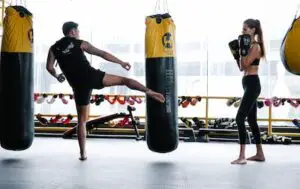Muay Thai, also known as “The Art of Eight Limbs,” is a traditional martial art form originating from Thailand. With a rich history that spans centuries, Muay Thai has evolved from a survival technique in warfare to become a respected sport and a way of life. In this article, we will explore the fascinating origins and the historical development of Muay Thai, shedding light on its cultural significance and its journey to becoming a global phenomenon.
What is the origin of Muay Thai?
Muay Thai, also known as “The Art of Eight Limbs,” is a martial art and combat sport that originated in Thailand. Its precise origin is a subject of debate among historians, but it is widely believed to have emerged several centuries ago as a fighting system used by the Thai people.
The development of Muay Thai can be traced back to the ancient Kingdom of Ayutthaya, which existed from the 14th to the 18th centuries. During this time, the kingdom faced numerous conflicts and wars, which led to the evolution of combat techniques to defend against external threats. Muay Thai’s roots can be found in a variety of martial arts practices prevalent in Southeast Asia at that time, including krabi krabong (a weapons-based martial art) and muay boran (an ancient form of bare-knuckle boxing).
Muay Thai gained significant popularity and recognition during the 18th century, particularly during the reign of King Prachao Sua (also known as the Tiger King). King Prachao Sua was a skilled practitioner of Muay Thai and helped elevate the art form by organizing competitions and incorporating it into military training for the royal army. Muay Thai matches were held in front of the king and the royal court, and the sport became deeply ingrained in Thai culture.
Over time, Muay Thai evolved into a systematic and highly effective combat sport. It combines the use of fists, elbows, knees, and shins, allowing fighters to employ a wide range of strikes and clinching techniques. The sport was traditionally practiced without protective equipment, and matches were often brutal and intense.
In the 20th century, Muay Thai underwent several modernizations and rule changes to improve safety and promote its growth as an international sport. The introduction of weight classes, the use of gloves, and standardized ring sizes were some of the significant changes implemented. Muay Thai has gained global popularity and has become one of the most widely practiced and admired martial arts disciplines around the world.
How did Muay Thai evolve through history?
Muay Thai, also known as “The Art of Eight Limbs,” is a martial art and combat sport that originated in Thailand. Its evolution through history can be traced back several centuries. The development of Muay Thai was influenced by various factors, including cultural, historical, and military influences. Here’s a brief overview of how Muay Thai evolved through history:
- Early Origins: The roots of Muay Thai can be traced back to ancient times in Thailand. It is believed to have evolved from an earlier martial art known as Muay Boran, which was practiced by Siamese soldiers for self-defense and warfare. Muay Boran incorporated striking techniques, clinching, and the use of various body parts as weapons.
- Royal Patronage: Muay Thai gained significant recognition and support during the Sukhothai era (13th-14th centuries) when it became popular among the Thai nobility and royal court. Kings and rulers would often organize competitions and use Muay Thai to select the best fighters for their armies.
- Development of Rules: Over time, rules and regulations were introduced to make Muay Thai safer and more structured. During the Ayutthaya period (14th-18th centuries), fighters began to use hand-wraps (Kard Chuek) made of horsehair or rope to protect their hands and wrists. This period also saw the introduction of timed rounds, referees, and the use of a ring (Satin).
- Influence of Western Boxing: In the late 19th century, Thailand underwent modernization efforts, including adopting Western practices. This period had a significant impact on Muay Thai’s evolution. Western boxing techniques, such as punching with closed fists and footwork, were integrated into Muay Thai, adding a new dimension to the art.
- Codification and Standardization: In the early 20th century, King Rama VII took a keen interest in Muay Thai and promoted its growth and development. The art was further formalized, and rules were established to regulate the sport. In 1929, the first official Muay Thai school, the Suan Muay Thai, was established in Bangkok. The art continued to evolve and gain popularity among the general public.
- Modernization and Globalization: In the latter half of the 20th century, Muay Thai gained international recognition and spread beyond Thailand’s borders. It became a popular combat sport, attracting practitioners and enthusiasts from around the world. International organizations were formed to promote and regulate Muay Thai, and it became a staple of various mixed martial arts competitions.
What role did Muay Thai play in Thai culture?
Throughout history, Muay Thai served as a form of combat training for soldiers, equipping them with essential skills for warfare. It was employed to defend the nation and its people against invading forces, allowing Thailand to maintain its independence and sovereignty. This martial art was deeply respected and revered for its effectiveness in battles.
Beyond its martial applications, Muay Thai became a celebrated cultural phenomenon. It is widely practiced and admired by people of all ages and backgrounds in Thailand. The sport is deeply ingrained in Thai society, with numerous training camps and stadiums scattered across the country.
Muay Thai’s influence extends beyond the sporting arena. It has become a symbol of national pride, showcasing the strength, discipline, and determination of the Thai people. Fighters are admired as local heroes, and their victories are celebrated with great fervor. Muay Thai competitions draw large crowds of spectators who cheer passionately for their favorite fighters, creating an electrifying atmosphere.
How did Muay Thai become recognized as a sport?
Muay Thai’s transition from a survival skill to a formalized sport began during the reign of King Naresuan in the 16th century. The king, himself a skilled practitioner, encouraged the development of organized matches and formalized rules, paving the way for Muay Thai’s recognition as a national sport. In the early 20th century, King Rama VII further promoted the sport by establishing the first national stadium dedicated to Muay Thai.
What are the key techniques and training methods of Muay Thai?
Muay Thai is renowned for its unique set of techniques, which utilize both striking and clinching maneuvers. The art emphasizes the use of fists, elbows, knees, and shins, earning its moniker as “The Art of Eight Limbs.” Training methods focus on developing strength, agility, endurance, and mental fortitude. Techniques such as punches, kicks, knee strikes, and defensive maneuvers are drilled through shadowboxing, pad work, heavy bag training, and sparring sessions.
How has Muay Thai gained global popularity?
In recent decades, Muay Thai has experienced a surge in popularity worldwide. Its inclusion in international martial arts competitions, such as the Mixed Martial Arts (MMA) arena, has contributed significantly to its global recognition. Additionally, the rise of martial arts movies, cultural exchange programs, and the spread of martial arts gyms have all played a part in increasing awareness and interest in Muay Thai on a global scale.
Conclusion
Muay Thai stands as a testament to the rich history and cultural heritage of Thailand. From its humble origins as a survival skill to its evolution into a respected martial art and sport, Muay Thai has captivated practitioners and spectators alike. Its blend of physical prowess, mental discipline, and cultural significance continues to inspire individuals worldwide. As Muay Thai’s popularity continues to grow, its timeless legacy as “The Art of Eight Limbs” will undoubtedly endure, carrying with it the story of its origins and the indomitable spirit of its practitioners.





